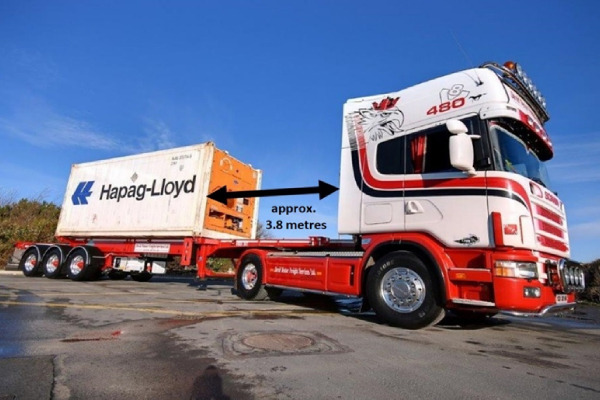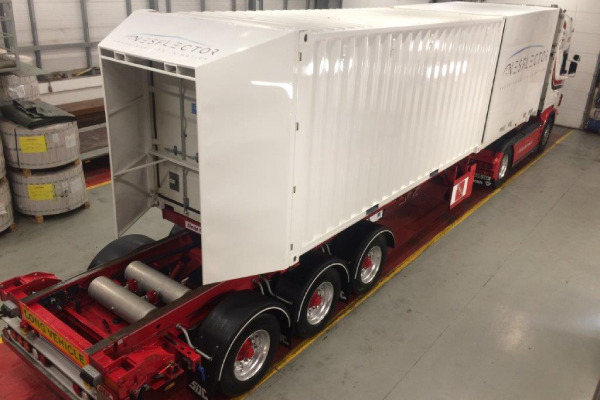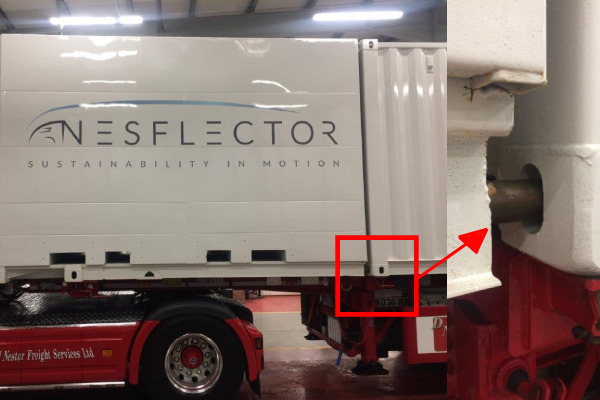Sustainability

Nesflector
For quite a while, David Nestor has been acutely aware of the impact road transport has on the environment. Emanating from very simple logic, David recognised that transporting large square containers on vehicles with imperfect aerodynamic shape to accomplish optimum fuel efficiency was an area worthy of some contemplation with a view to identifying aspects which could be improved.
David Nestor conceived the Nesflector Lolo Drag Reduction System.
Provided below is an article from the Freight Business Journal which showcased David’s invention, the Nesflector LoLo Drag Reduction System.
Container transport needn’t be a drag says Irish firm
Irish-based Inventiveness (ONE) Limited, the owners of the intellectual property related to the Nesflector LoLo Drag Reduction System, have designed a practical solution to reduce fuel burn for container road transport.
When 20ft containers are transported on conventional semi-trailers, there is a large gap between the rear of the tractor unit cab and the front of the container due to regulations based on such parameters as axle loading, weight distribution or turning radius.
However, the resulting void creates turbulence and pressure drag, and this in turn leads to increased fuel burn and, of course, more greenhouse gas emissions (GHGs).
The focus of the Nesflector project is divided into addressing two problematic aspects:
- The gap between the rear of the cab and the front of the container.
The Nesflector IVEAS (Interchangeable Void Eliminating Aerodynamic Shape) is the device designed to alter and improve the impact of turbulence and pressure drag caused by this area of inefficiency. This air deflection device is inserted into the gap to improve air flow across the vehicle and container combination. Aerodynamic studies have revealed that every 300mm reduction in the gap between cab and container cuts pressure drag by 2.6% and a 1% decrease in pressure drag roughly equates to a 0.5% decrease in fuel burn.
Most European vehicles transporting 20ft containers have a gap of about 3.8 metres between the rear of the cab and the front of the container, this equates to a 32.5% pressure drag, which, if eliminated, would cut fuel burn by 16.25%.
- Turbulence and pressure drag at the rear of the vehicle.
The Nesflector boat tail has been developed to target turbulence and pressure drag caused by the bluntness of the back end of semi-trailers.
There will be two versions of the Nesflector boat tail device – fixed position and retractable base versions. The retractable base version will enable the Nesflector to be retracted from contact with the container for easy positioning or removal of the container from the semi-trailer. The Nesflector boat tail is designed to be coupled in place using container corner castings and twist locks which form part of the container and semi-trailer.
This means there is no requirement for new attachment points.

This boat tail is the result of research and development into the pressure drag created by the large wake resulting from the bluntness of the back end of semi-trailers and it has been demonstrated adding one to the rear end of semi-trailers can contribute a 6.5% decrease in fuel burn.
Combining the Nesflector IVEAS with a Nesflector Boat Tail, Inventiveness (ONE) Limited says it can reduce fuel burn by up to 22.75%.
It adds that the Nesflector IVEAS concept is unique; there are no other pressure drag-reduction solutions targeting container transport in existence.
The unit cost is relatively low, it adds, because the materials and design are eminently suitable for simple manufacture using standard fabrication and moulding processes. It is also interchangeable between vehicles, and the device is easily handled by a standard forklift truck.
The container corner castings are used to securely anchor the Nesflector devices in position.

The company anticipates that Nesflectors can be created suitable for specific regions, according to local vehicle construction and use regulations.
Nesflectors have been designed to be handled and stored in a similar manner to the containers they are to be paired with. They can also be allocated ‘BIC’ identification codes to allow easy allocation to the correct driver.
With governments increasingly conscious of greenhouse gas emissions, Inventiveness (ONE) Limited adds that it is not inconceivable that, where practically achievable, the use of Nesflectors could become mandatory.
Transport operators could hire Nesflectors as required from container leasing companies and they could be sourced from existing container depots.
As fuel costs continue to soar, the commercial justification for use of the Nesflector LoLo Drag Reduction System is becoming more and more compelling.
